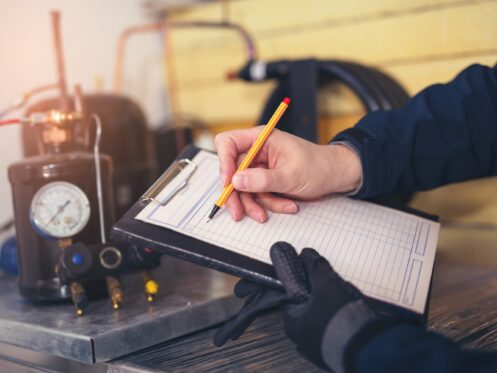It’s never too early to begin making preparations for the fall. Take care of your home and yard with a seasonal maintenance checklist. Autumn is a great time to ensure that all areas of your residence are in optimal condition as the weather gets cooler. From clearing gutter debris and inspecting sump pumps to checking and cleaning your air filters, there are many key fall maintenance points to keep track of, so don’t let time get away from you. Here is an essential guide on how to stay ahead of completing important tasks each year.
1. Clear Gutter Debris
With leaves and other debris piling up, gutters can quickly become clogged and cause serious damage to your roof. Make sure to clean out any debris and inspect the gutters for any wear and tear so that they can function properly. This will also help keep your home safe from water damage.
Gutters help direct water away from your house and toward a designated spot, like a flower bed or garden. This is especially important in areas with heavy rainfall during the fall months. With proper gutter maintenance, you can ensure that your home stays safe from any water-related damage.
2. Inspect Sump Pumps
Sump pumps are responsible for preventing flooding in your home’s basement or crawl space. They pump out excess water and direct it away from the foundation of your house, safeguarding against potential property damage. It is important to regularly inspect your sump pump and clear any debris that could potentially block the intake or outlet.
If you have a backup power source for the sump pump, check to ensure that it works properly in case of a power outage so that your home remains protected from flooding, even during severe weather conditions.
3. Clean and Replace Air Filters
Air filters should be cleaned and replaced regularly throughout the year to keep your heating and cooling system running optimally. It is especially important to check them before switching from air conditioning to heat for the winter season. A dirty filter can cause problems like higher energy costs and air quality issues, so change them frequently.
In addition, check any other filters in your home that are responsible for removing dirt and debris from the air. This includes range hoods, bathroom fans, and dryer vents. By changing these regularly, you can help reduce the amount of dust in your home and keep the air healthy all year long.
4. Check Smoke and Carbon Monoxide Detectors
During the fall months, many people use their heating systems and fireplaces for the first time. This makes it essential to check all smoke and carbon monoxide detectors in your home. Replace any old or malfunctioning batteries and test each to ensure that they function properly.
5. Examine the Roof and Attic
Inspect your roof for any missing or damaged shingles and general wear and tear that may have occurred over the past year. Make sure to repair any visible holes, cracks, or other damage so that your roof can remain in good condition throughout winter. If you’re not comfortable making roofing repairs, contact a professional to help you.
Also, check out your attic and ensure it is properly sealed and insulated to help prevent heat loss. While there, look for any signs of moisture or mold that could indicate a possible leak. This will help you identify any potential problems before they become serious.
6. Listen for Weird Noises
Because of the cooler temperatures, your HVAC system may start to make weird noises as you switch from cooling to heating. Pay attention to any strange sounds from the air ducts or vents, and contact a professional if anything seems out of place.
Noises like whistling, chirping, or buzzing could indicate something wrong with your heating system. One of the most common reasons for these noises would be a fan belt that needs to be replaced among other potential issues. For residents of Gilbert, AZ and the surrounding areas, A/C & Plumbing Doctors can provide a professional inspection to diagnose any underlying problems and get your heater running properly.
7. Examine Windows and Doors
Check all windows and doors around your home for drafts, gaps, or other damage that could let in cold air during the winter months. Sealing up any openings with weather stripping or caulking to keep your living space nice and cozy throughout the fall.
Also, inspect any windowsills or door frames for signs of rot, water damage, or decay. If necessary, replace these components with weather-resistant materials to help protect your home from moisture buildup during the colder months ahead. This will prevent cold air from entering your home or hot air from escaping, helping you save money on energy costs.
8. Inspect Outdoor Fixtures
Inspect any outdoor lights, faucets, or other fixtures that you may have around your house. Turn off the water supply to these items and drain any remaining liquid to prevent freezing during winter.
Check for any signs of rust or wear-and-tear on exterior components like railings or porches. Make repairs with weather-resistant materials to keep your home looking great during the fall months. When checking your outdoor fixtures, do not forget to look for any signs of pests that may have taken up residence near your home. This protects both you and your property from any potential risks.
9. Clean the AC Compressor
The compressor in HVAC systems is responsible for cooling and circulating air throughout the house. Clear away any debris accumulated around it over the summer months. This will help keep your system running efficiently when you switch back to heating in the fall.
Also, check for any signs of rust or corrosion on the compressor as this can cause problems with its performance during colder weather conditions. If necessary, contact a professional to clean and repair your air conditioning unit so that it will be ready for use again when you need it.
10. Inspect and Insulate Pipes
Pipes are especially susceptible to freezing and bursting when temperatures are low. Check all the pipes inside and outside your home for any signs of wear and tear or damage. If necessary, replace old or damaged piping with new materials more resistant to freezing temperatures.
In addition, inspect all exposed pipes outdoors and insulate them using a foam sleeve or pipe wrap. This will help keep them from freezing and save you money on potential repairs in the future. Disconnecting hoses from outdoor faucets is also important to avoid any broken water lines that result from low temperatures.
Fall is a busy season for many Gilbert area homeowners as they prepare their homes for the months ahead. Following this fall maintenance checklist, you can ensure that your home remains in top condition throughout the season and be ready for anything. At A/C & Plumbing Doctors, we provide heating, air conditioning, and plumbing services. Our highly skilled professionals provide unmatched services to ensure your comfort and safety throughout the fall season. Contact us today to book a service.





